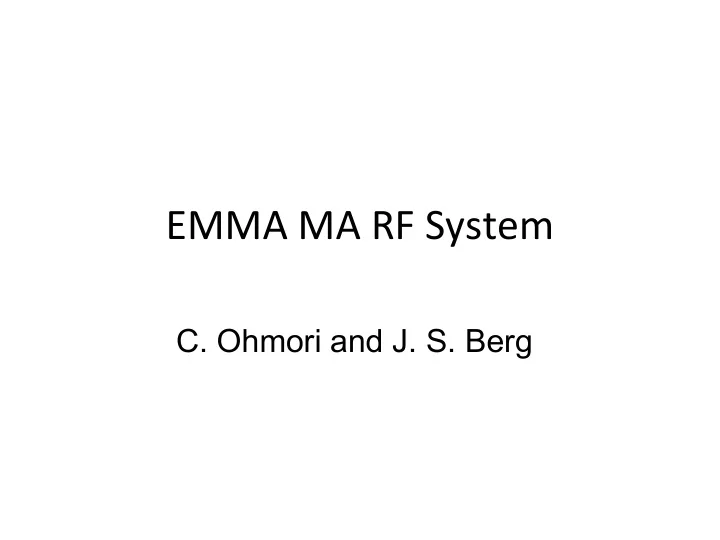

EMMA MA RF System C. Ohmori and J. S. Berg
EMMA MA System * Many FFAG applications require slow acceleration * Linear non-scaling FFAGs cross many resonances - Nonlinear resonances - Imperfection resonances * Resonances damage beam more when you cross them slowly * There is thus a minimum rate at which you can cross resonances - May depend on magnitude of errors (Machida) 10 -2 6 4 normalized DA [ m rad] * Low-frequency RF to allow slow acceleration 2 - EMMA as-is only allows very rapid acceleration 10 -3 - Primarily due to high-frequency RF system 6 4 2 * Accelerate rapidly then reduce rate 10 -4 - Start with 100 turns to insure success 6 4 - Reduce acceleration rate and study effects 100 Turns 2 1,000 Turns 10 -5 FFAG09 0 20 40 60 80 100 1 of alignment error [ m]
Parameters of MA system Frequency 18 MHz comments Frequency sweep 3 % Possible up to ~8% Total voltage 100 kV 100 turns / cycle Number of cavities 3 Voltage 33.3 kV / cavity 50 kV to run further off-crest Length of cavity 10 cm Number of cores 2 / cavity Size of core 27 O.D, 10 cm ID, 2.5 cm thickness Cut/un-cut core Cut core Q-value About 11 1000 Ω Cavity impedance FT3L will be used. Core material FT3M FFAG09
EMMA MA CAVITY FFAG09
Technical Issues to solve Need high impedance to get > 33 kV/cavity • High impedance MA cores Resonant frequency at 18 MHz • Cut core cavity High voltage in a small space • Space around beam pipe to avoid discharge Ceramic gap to stand high voltage of > 1.6 kV/mm High power amplifier and power supply • Compact AMP and PS for low duty FFAG09
Cavity Impedance Assuming ordinary MA material is used The cavity will have about 600 Ω at 18 MHz Large O.D/I.D ratio is necessary. If I.D. is 10 cm, O.D. will be about 30 cm. Assuming to use PRISM amplifier to drive − Rf current of 60 A is available. About 30 kVp per cavity might be achievable ? If cavity impedance is high, higher voltage can be obtained and/or system will be compact . FFAG09
Improvements of cavity impedance uQf (磁性体コアの特性) We are interested in higher • impedance core for J-PARC 14 beam-power upgrade. 12 ∝ shunt impedance 10 A new material (FT3L, 13 µ m • uQf (GHz) 8 thickness) has two times higher impedance than 6 ordinary Magnetic Alloy 4 uQf(FT3L,13um) (FT3M, 18 µ m) . uQf(FT3L,18um) 2 uQf(FT3M,18um) 0 So far, up to 10 cm core was • 0 1 2 3 4 5 6 available. Now, up to 27 cm frequency (MHz) core becomes available. More than two times higher impedance is expected at higher frequency. Gap voltage will be twice higher if amplifier has enough power. FFAG09
Improvement of cavity impedance 4 MA cores using a new material is produced (27 cm O.D) for J-PARC R&D. Impedance measurement, next week. Preliminary results are good as we planned : 500 Ω /core. Test of immersion and cut core are next step for J-PARC and EMMA. These cores will be references (or used) for EMMA MA system design. Using high impedance core, FT3L core with 27 cm O.D. system design will be easy. FFAG09
Cut core configuration Un-cut core has a larger inductance and the resonant frequency will be low because of floating capacitance in cavity and amplifier. Cut core configuration is a possible way to reduce the inductance. High impedance will increase Q-value and it is preferable as it can avoid waveform distortion. Obtained bandwidth is wide much enough to sweep frequency by 3%. Floating capacitance About 100 pF 0.8 µ H Core inductance 1000 Ω Shunt impedance Q-value About 11 Bandwidth 1.5 MHz FFAG09
Ceramic Gap Length of ceramic gap will be about 2 cm because cavity length is 10 cm. 30 (-60) kV will applied on it. Ordinary ceramic pipe can not stand for 1 kV/mm on surface. Need to stand at 1.5 (-3) time higher voltage. A new ceramic made by Kyocera can stand 4 times higher field (4kV/mm). A beam pipe for J-PARC RCS cavity #12 will use it. FFAG09
Compact amplifier and anode power supply Peak RF power is 400 kW 33.3 kV X 24 A To save the system cost,pulse operation of small vacuum tubes is preferable. Duration is 5.6 µ s (100 turns/18 MHz) and repetition rate is small (~1 Hz). PRISM amplifier and anode power supply can be used. 50 kW tetrodes, 4CW50,000, can be used. (150 kW tubes, 4CW150,000, are used for PRISM) Specification of APS is much smaller than PRISM. Combination of small DC PS and capacitor bank will reduce cost. o PRISM amplifier still sufficient for 50 kV FFAG09
summary RF system using MA cavity is designed. Using a new MA material, FT3L, the system will be compact and fit all requirements. If you need 2 times faster acceleration, PRISM amplifier and APS will be a suitable system to drive. R&D on FT3L and new ceramic are carried on at J-PARC for upgrade. FFAG09
Recommend
More recommend